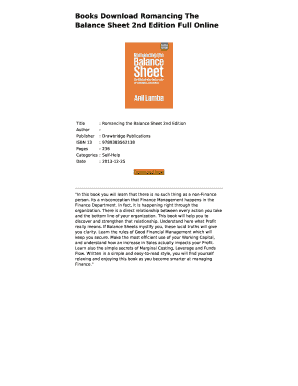Romancing The Balance Sheet Pdf
Free PDF ebooks (user's guide, manuals, sheets) about Romancing the balance sheet pdf download ready for download.
Click the PDF, Kindle or ePUB icon below to in your chosen format. Book Description - ISBN 978-1-62620-954-1 (35 Pages) This free eBook you will give you a thorough understanding of the balance sheet, a powerful decision-making tool that every manager should be familiar with. Chapter 1 - The balance sheet, together with the income statement and cash flow statement, make up the cornerstone of any organization's financial statements. The main concept of a balance sheet is that total assets must equal the liabilities plus the equity of the company at a specified time. Chapter 2 - Assets include things like stock/inventory, buildings, equipment, and money owed to the company. Liabilities include money owed by the company to suppliers and its own workers in the form of wages that have not yet been paid. Equity includes net assets, often referred to as shareholder equity, and consists of issued capital and reserves, both controlling interests, as in a parent or holding organization, and non-controlling interest in equity.
Chapter 3 - Current assets include cash and cash equivalents, short-term investments, accounts receivable, and bad debt provision. Inventory includes raw materials, work in process, and finished goods. Prepaid expenses are those things that have been paid in advance like insurance premiums, property taxes, and income tax installments.

Property and equipment includes such items as buildings, manufacturing equipment, vehicles, and office equipment. Chapter 4 - Liabilities are a company's legal debts or obligations that arise during the course of business operations and include loans, accounts payable, mortgages, deferred revenues, and accrued expenses.
Os X Leopard Dmg Rapidshare. Current liabilities are those that will become due, or must be paid, within one year. Chapter 5 - Equity is the difference between total assets and total liabilities. The items that will appear under this section include loans from shareholders, capital stock, contributed capital, and retained earnings. Chapter 6 - An organization's balance sheet allows you to determine its liquidity and solvency as well as the ratios of its tangible and intangible assets. You can also use it to determine key ratios like the current ratio and the quick ratio. Tmnt 2007 Game Pc on this page. Creative Labs Vf0250 Driver Mac. Assessing the ability of an organization to liquidate its tangible assets will give you an idea of how well it could deal with a liquidity problem. Chapter 7 - Performing a common-size analysis on a balance sheet can be done either horizontally or vertically.
A vertical common-size analysis expresses inventory, liabilities, and equity as a percentage of total assets. A horizontal common-size analysis compares the change year on year for each item of the balance sheet enabling you to look at how an item has changed relative to total assets. You will learn: • Exactly how assets, liabilities and equity are defined and documented • How to use a balance sheet to determine an organization's liquidity and solvency • How the balance sheet and other key financial documents fit together • How to perform a vertical and horizontal common size analyses to detect changes in an organization's financial status • How to assess the ability of an organization's management by using key financial ratios Easy to Follow This book starts off by explaining how a balance sheet is made up for a VERY simple company. It describes how each item has been arrived at and what it means in everyday terms.